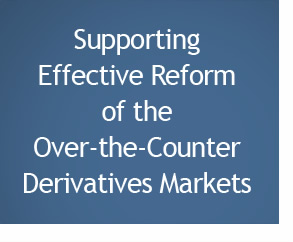02/02/11 - Wall Street & Technology - By Ivy Schmerken
|
|
Large Players Worry About Dodd Frank Swap Regs
Large dealers and asset managers expressed concerns about Dodd Frank's 'big bang' approach to reforming swaps markets, noting that the rulemaking was rigid and the time frame was unrealistic.
"We need to think of the rules as having sufficient flexibility to give the market participants using the products today a reason to continue using them," said Lee Olesky, CEO of Tradeweb, who spoke at TabbForum's derivatives reform conference in New York City last week.
Conveying that the multiple moving parts to the swaps overhaul, Lee Olesky, said the first critical reform is flexibility and the second is synchronicity. Citing the roles played by depositories, swap execution facilities (SEFs) to clearing firms, Olesky said, "Everyone has a role to perform. That's why there is a need for synchronicity."
Participants on the panel said they were engaged with the SEC and CFTC. "It's somewhat of a shotgun marriage," commented Jamie Cawley, CEO of Javelin Capital Markets. With the deadline for implementing the Dodd-Frank derivatives rules looming in July, Cawley said, "There is a lot of work to be done."
Market confidence was a topic that participants brought up as if the uncertainty over the final regs could damage that. "This is a monumental change. The idea of a healthy and vibrant market is only going to be obvious when you are in the market after," commented Brad Levy, managing director in the Principal Strategic Investments Group at Goldman Sachs. But Levy added, "There is a logical way to roll these rules out and impose them on the market."
While focusing on preserving liquidity in the swaps markets, participants seemed to forget why the radical reforms were being imposed on the swaps industry. Javelin's Cawley reminded the panel why this was happening. "On a macro-level, the reason we're all here is because of September 2008… to make sure the systemic risk that exists as a byproduct of the market is addressed. Replacing bilateral contracts with clearing agreements," was central to the reforms, he suggested.
Several participants agreed that clearing was the most critical component to attack first. “Things like transparency, pre-and post-trading on SEFs, while important… it seems like the core goal is to clear more and to get out of the bilateral form, have confirms and mark-to-market every day and margin and collateral calls,” said Levy.
Market participants cautioned the audience that the new swap rules could damage the swap markets and cause liquidity to disappear. In particular they agreed it was important for the SEF rules to define the block size for swaps correctly. “In some financial futures, $5 billion is a block. In some commodities, $100 million is a block. Those two components, clearing and block size, getting that right is critical,” commented Chris Ferreri, managing director at interdealer broker ICAP.
BlackRock managing director Richie Prager pointed out that clearing has been going on for a long time via LCH.Clearnet or ICE (Intercontinental Exchange as well as clearing of bespoke (a.k.a. customized) arrangements with a tri-party agreement. Prager was less worried about clearing, but what could impair the deep and liquid swap markets were the SEF rules. “Those are the brave new world.”
One big concern of large asset managers is the block sizes as defined by the SEF rules, and whether block trades are exempt from the new data reporting requirement. “As buy-side firms we’re part of an ecosystem. If we disrupt the balance, our investors would have to pay the risk premium,” said Prager. “When you think about the block sizes, those are a very big concern,” added Prager. “These are things that can disrupt the buy-side firm.”
While the SEF rules are not finalized yet, many people have questions and comments, said Olesky. Even so, Tradeweb, which began offering electronic trading 12 years ago in fixed income, sees a massive opportunity to bring these instruments onto an electronic trading environment, said Olesky. But he prefers to see “more flexibility to allow systems to compete and innovate and have a more expansive approach, rather than a more rigid approach,” he said.
Newcomers are also seeing an opportunity. “If you get transparency people get to see bids and offers over the screen. No longer is this over the phone,” said Cawley of Javelin Capital Markets, an electronic trading venue for interest rate and credit default swaps (CDS). “Bringing in new participants could lead to new liquidity,” added Cawley.
However, the regulatory push toward electronic trading of standardized swap contracts is not realistic, suggested participants. ICAP’s Ferreri warned that every clearable swap contract couldn’t necessarily be traded electronically. Pointing to ICAP’s long history in electronic trading of US Treasuries since 1999, Ferreri said algorithms are used every day. But, he noted, the off-the run Treasury trades are still executed via voice brokers. “So, in the most actively traded and most liquid market in the world there is still an off-the-run component,” explained Ferreri. He noted, there are certain conditions of liquidity that have to be met. If you put everything in one bucket and say this is how you trade it, it can’t be done. But Ferreri said this is the “first cut” of the regs. |



